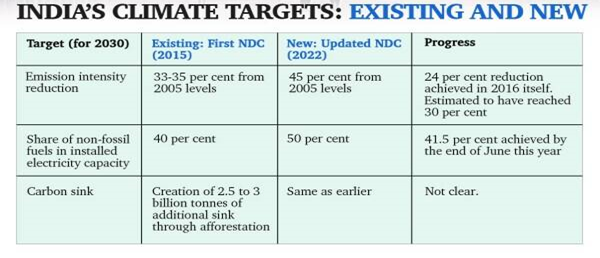

Context
Since the Prime Minister has made promises at the climate change conference at Glasgow, the government now has converted two of those into official targets, which would now be part of India’s International climate commitments for 2030.
About
- India’s first Nationally Determined Commitment (NDC) was submitted in 2015, just before the Paris Agreement was finalised.
- India’s original NDC contained three main targets for 2030:
- A 33 to 35 per cent reduction in emissions intensity (or emissions per unit of GDP) from 2005 levels
- At least 40 per cent of total electricity generation to come from non-fossil renewable sources
- An increase in forest cover to create an additional carbon sinks of 2.5 to 3 billion tonnes of carbon dioxide equivalent
|
What is Carbon dioxide equivalent? A CO? equivalent (CO?e) is a unit of measurement that is used to standardise the climate effects of various greenhouse gases.
|
- Again at the Glasgow meeting held in 2021, India has promised to strengthen India’s climate commitments. Those were five promises, and called it the ‘Panchamrita’.
|
The Panchamrita Points
|
- Two of these were forward revision of existing targets, the ones that have been made official and put in the updated nationally determined Commitments (NDC).
What changes have been made in predetermined targets?
- Emission intensity: India will now has to reduce its emission intensity by at least 45 per cent, instead of just 33 to 35 per cent, from 2005 levels by 2030.
- Electricity generation from renewables: It would now ensure that at least 50 per cent of its total electricity generation, not just 40 per cent, would come from renewable sources by 2030.
- Conserving forest: And the forestry target has not been touched.

Which targets were further added as NDC by India?
India has determined to achieve the goals till 2030 with making the below goals addition to them:
- At least 500 GW of India’s installed electricity generation capacity in 2030 would be based on non-fossil fuel sources.
- Also, the country has pledged to ensure avoided emissions of at least one billion tonnes of carbon dioxide equivalent between now and 2030.
|
Net-zero emissions India has also promised for Net-zero emissions till 2070; which means that a situation in which a country’s greenhouse gas emissions are offset entirely, either by absorption of carbon dioxide through natural processes like photosynthesis in plants, or through physical removal of greenhouse gases using futuristic technologies. |
Present situation
- India’s emissions intensity was 24 per cent lower than the 2005 levels in the year 2016 and it is very likely that the 33 to 35 per cent reduction target has already been achieved, or is very close to being achieved as per the official data.
- 5 per cent of India’s current installed electricity capacity of 403 GW is now powered by non-fossil fuels.
- Renewables (wind, solar and others) alone account for more than 28 per cent of this capacity while hydropower contributes over 11 per cent.
India’s Hardships to eliminate coal
Contrary to the Official reports of India, Global stance regarding India’s situation is a bit different.
- According to some estimates, India’s annual projections are expected to rise from about 3.3 billion tonnes in 2018 to about 4 billion tonnes by 2030.
- Thus, India could be emitting anywhere between 35 to 40 billion tonnes of carbon dioxide equivalent in total by the year 2030.
- A reduction of one billion tonnes from this would represent 2.5 to 3 per cent. Some officials argue that if India achieves its official targets, the gains in terms of avoided emissions could be far in excess of one billion tonnes.
- Vagueness in India’s speech for targets at Glasgow had mistakenly used ‘energy’ for ‘electricity’ and ‘renewables’ for ‘non-fossil energy sources’, which makes a lot of difference.
Government Interventions in path of achieving those targets
- Reforms in Transport Sector: India leapfrogged from Bharat Stage-IV (BS-IV) to Bharat Stage-VI (BS-VI) emission norms by April 1, 2020, the latter being originally scheduled for adoption in 2024.
- India's Support to EVs: India has taken various measures to develop and promote the EV ecosystem:
- The remodelled Faster Adoption and Manufacturing of Electric Vehicles (FAME II) scheme
- Production-Linked Incentive (PLI) scheme for Advanced Chemistry Cell for the supplier side
- The recently launched PLI scheme for Auto and Automotive Components for manufacturers of electric vehicles.
- Role of Industries in Low-Carbon Transition:The public and private sectors in India are already playing a key role in meeting the climate challenge, helped by growing customer and investor awareness, as well as increasing regulatory and disclosure requirements.

